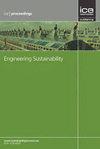Enhancing the detection performance of a vision-based occupancy detector for buildings
IF 2.5
4区 工程技术
Q3 ENGINEERING, CIVIL
Proceedings of the Institution of Civil Engineers-Engineering Sustainability
Pub Date : 2022-07-04
DOI:10.1680/jensu.22.00013
引用次数: 0
Abstract
Occupant behaviour is one of the key parameters that significantly impact the operation of heating, ventilation, and air-conditioning (HVAC) systems and the energy performance of buildings. The detailed occupancy information can improve HVAC operation and utilisation of building spaces. Strategies such as vision-based occupancy detection and recognition have recently garnered much interest. This study investigates the performance of a vision-based deep learning detection technique for enhancing building system operations and energy performances. The model used was the Faster RCNN with Inception V2. Two occupancy detection model configurations were developed, tested and evaluated. Both models were analysed based on the application of the detector within a selected case study building, along with the evaluation based on the different evaluation metrics. Results suggest that the occupancy detector (Model 1) provided an overall accuracy of 95.23% and an F1 score of 0.9756, while the occupancy activity detector (Model 2) provided an accuracy of 89.37% with an F1 score of 0.8298. Building Energy Simulation (BES) was used to evaluate and compare the impact of such an approach on the indoor occupancy heat gains. The study highlighted the potential of the detection approaches, but further development is necessary, including optimisation of the model, full integration with HVAC controls and further model training and field testing.提高基于视觉的建筑物占用探测器的检测性能
居住者的行为是影响供暖、通风和空调(HVAC)系统运行和建筑能源性能的关键参数之一。详细的占用信息可以改善暖通空调的运行和建筑空间的利用。诸如基于视觉的占用检测和识别等策略最近引起了人们的极大兴趣。本研究探讨了一种基于视觉的深度学习检测技术的性能,以增强建筑系统的运行和能源性能。使用的模型是带有Inception V2的Faster RCNN。开发、测试和评估了两种占用检测模型配置。基于探测器在选定的案例研究建筑中的应用,分析了这两种模型,以及基于不同评估指标的评估。结果表明,占用检测器(模型1)的总体准确率为95.23%,F1得分为0.9756;占用活动检测器(模型2)的准确率为89.37%,F1得分为0.8298。利用建筑能量模拟(BES)来评估和比较这种方法对室内占用热增益的影响。该研究强调了检测方法的潜力,但还需要进一步的开发,包括优化模型、与暖通空调控制的完全集成、进一步的模型培训和现场测试。
本文章由计算机程序翻译,如有差异,请以英文原文为准。
求助全文
约1分钟内获得全文
求助全文
来源期刊

Proceedings of the Institution of Civil Engineers-Engineering Sustainability
ENGINEERING, CIVIL-ENGINEERING, CIVIL
CiteScore
3.70
自引率
16.70%
发文量
44
审稿时长
>12 weeks
期刊介绍:
Engineering Sustainability provides a forum for sharing the latest thinking from research and practice, and increasingly is presenting the ''how to'' of engineering a resilient future. The journal features refereed papers and shorter articles relating to the pursuit and implementation of sustainability principles through engineering planning, design and application. The tensions between and integration of social, economic and environmental considerations within such schemes are of particular relevance. Methodologies for assessing sustainability, policy issues, education and corporate responsibility will also be included. The aims will be met primarily by providing papers and briefing notes (including case histories and best practice guidance) of use to decision-makers, practitioners, researchers and students.
 求助内容:
求助内容: 应助结果提醒方式:
应助结果提醒方式:


